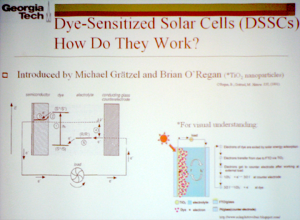
2011 Spring Meeting
One of the most important efforts in photovoltaic cell research and development is the relentless drive to reduce costs. Researchers usually find that a new less expensive technology brings with it an efficiency lower than the more expensive cells. Current research on the use of new structures in zinc oxide nanowires to enhance PV cell efficiency is being performed at Georgia Tech University, and some preliminary results were presented by Mallarie McCune on Tuesday.
Starting Points
One of the study areas for low-cost, organic-based solar cells is in the area of Dye Sensitized Solar Cells (DSSC). In these cells, an organic dye in electrolyte solution absorbs the photons and transfers the resultant electron to a metal-oxide layer deposited on a glass (FTO) substrate. In this DSSC setup, three of the rate-limiting issues which lead to low electrical efficiencies are electrode surface area, electrode composition and back transfer (short-circuiting) at the glass surface. In this report, the results of experiments reported include:
- Use of zinc oxide (ZnO) as the electrode material (previous work had been done using titanium dioxide (TiO2)).
- Grow nanowires of ZnO on the FTO to enhance the surface area on an atomic level.
- Use polymer masking agents to "cover" the areas between the nanowires to eliminate the short-circuiting.
Experiments and Results

The ZnO nanowires were grown from a dilute (25 mili-molar [mM]) suspension, using an original seed layer coating of zinc acetate. Instead of trying to coat the openings after the nanowires were grown, a copolymer mixture was spin coated to a minimal thickness on the preseeded FTO. Subsequent chemical processing essential removed one of the constituents of the copolymer which resulted in a patchwork pattern of coated and uncoated seed layer. Now, when the ZnO nanowires were grown, the only sprouted from the uncoated areas, and thus an anti-short-circuiting coating resulted. Electrical efficiencies, which started extremely low in the uncoated case, jumped from .01% to .13%, a 13 fold increase.
The next phase involved reseeding the nanowire surface with zinc acetate and growing another "dimension" of wires onto the first. This showed efficiency increases, so three more rounds (we're now in the Fourth Dimension!) of nanowires were grown, and the electrical efficiency increased another threefold to .45%. Finally, an experiment with 5 layers (cue "The Age of Aquarius"), but grown from a 50 mM solution resulted in a whopping 1.5% electrical efficiency.

Next Steps
Work continues along several fronts, including using alternate dyes, alternate coating materials, and testing new redox couples that will (hopefully) eliminate the iodine (I2) "quenching" effect (reduced spectral absorption) in the electrolyte. For more information, contact Mallarie McCune.


